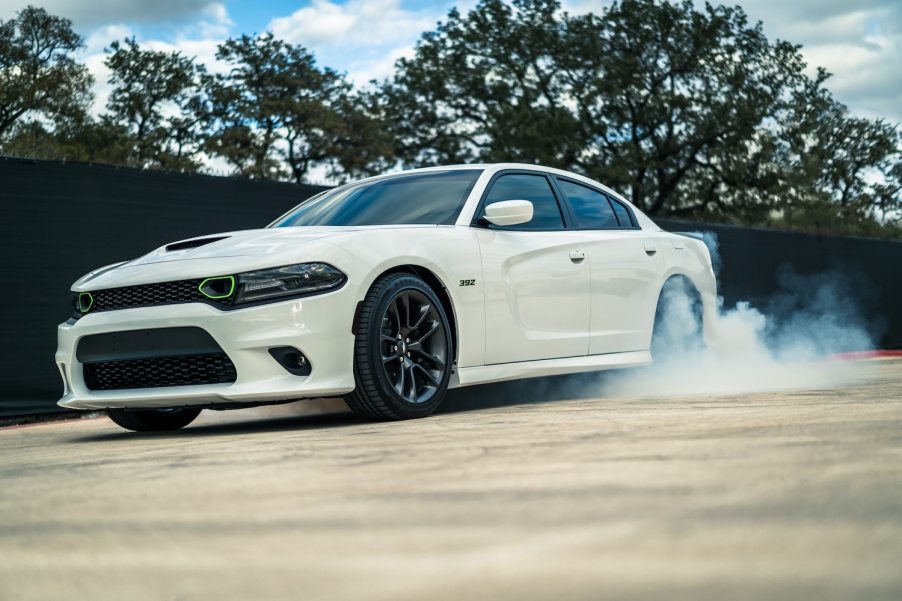
Do You Know How Much Horsepower the Average Car Actually Has?
There are many items on a car that shoppers and car enthusiasts prioritize. From comfy seats to exciting paint colors to clever infotainment and safety tech, everyone has their primary concern. However, one common detail people place immense importance on is horsepower—typically, the more, the better.
Horsepower is the oft-cited figure used as a foundation for bragging with speed-obsessed drivers. While horsepower is a ubiquitously advertised measure of engine power, people may need help understanding how the figure is derived.
What is horsepower?
Scottish inventor James Watt worked to innovate stationary industrial steam engines in the middle of the Industrial Revolution. He was trying to stir up interest in his improvements, but one essential factor needed to be added. How could he prove his engine was better if there was no way to measure power output? As horses were a primary means of getting work done, Watt looked to them for the solution.
Watt began observing horses closer as they pulled, pushed, and lifted heavy loads in the United Kingdom’s factories, mills, and mines. According to Car and Driver, Watt monitored a particular equine task. Lashed to spokes radiating from a mill’s central shaft, horses would turn the shaft by walking in a circle 24 feet in diameter. Each horse completed the process approximately 144 times in an hour, each pushing with an estimated 180 pounds of force.
From this, Watt determined that one horsepower was equivalent to one horse doing 33,000 pound-feet of work per minute. His reasoning is depicted by one horse raising a 33-pound bucket of water from the bottom of a 1,000-foot-deep well in 60 seconds. Consequently, that amount of work equals one horsepower. Watt got the marketing magic to revolutionize industry and transportation—and other force measurements—and it’s still the base of car power figures today.
How much horsepower does the average car have?

Engine horsepower has come a long way since Watt, especially once internal combustion engines became mainstream. While the first, the Benz Patent-Motorwagen, had two-thirds of a horsepower, today’s cars have much, much more.
J.D. Power says the average horsepower rating for standard modern vehicles is somewhere around 180. Yet, that’s an average across the dozen or so types of vehicles found at local dealerships.
Small, economy-minded vehicles like Hyundai Elantra, Subaru Impreza, and Kia Forte typically have between 130 and 170 horsepower. Midsize cars like the Acura TLX, Toyota Camry, and Volkswagen Passat usually have no less than 180 horsepower, with many harboring over 200. Large cars will have at least 200 horsepower and go up from there. While many stop near the 300-horsepower mark, sporty models can have more than double that. For example, the base model Dodge Charger has 292 horsepower, whereas the SRT Jailbreak model has 797.
SUVs and trucks will have different horsepower ratings. They generally weigh much more than sedans and hatchbacks, so they need more power to move them along. Midsize trucks like the Chevrolet Colorado, Ford Ranger, and Toyota 4Runner usually have at least 240 horsepower. Some may have over 300, but that’s typically with help from forced induction. Full-size SUVs and trucks like the Chevrolet Tahoe, Nissan Titan, and RAM 1500 will have horsepower figures in the mid-300 range. Yet, getting an SUV or truck with 400 horsepower without any wild modifications is quite common.
Is there such a thing as too much horsepower?
Speaking of wild modifications, many abide by the phrase “more equals better,” especially with horsepower. Yet, as Lord Acton once said, “absolute power corrupts absolutely.” An immense amount of horsepower seemingly licenses individuals to try to use all of it, even if it’s too much for the road.
In terms of traction, the term “too much” power can be found in whether or not the car is front-wheel or rear-wheel drive. 250 to 300 horsepower is the general limit for the front differential to handle while managing torque steer and understeer.
With rear-wheel drive, 600 horsepower is likely the magic number without causing too many problems. With more power, it’ll be pretty easy to spin the tires and crash—ask any Dodge Viper or Ford Mustang owner.
Does horsepower matter?
There is no question that horsepower matters, but it shouldn’t be the sole characteristic of the car. Yet, automakers market power figures heavily. While more power means drivers can accelerate faster, one could also enjoy a lower-power vehicle that weighs less.
If speed is a priority, horsepower shouldn’t be the sole concern. Numerous figures affect vehicle performance, including aerodynamics, gearing, tires, torque, weight distribution, and many others.


